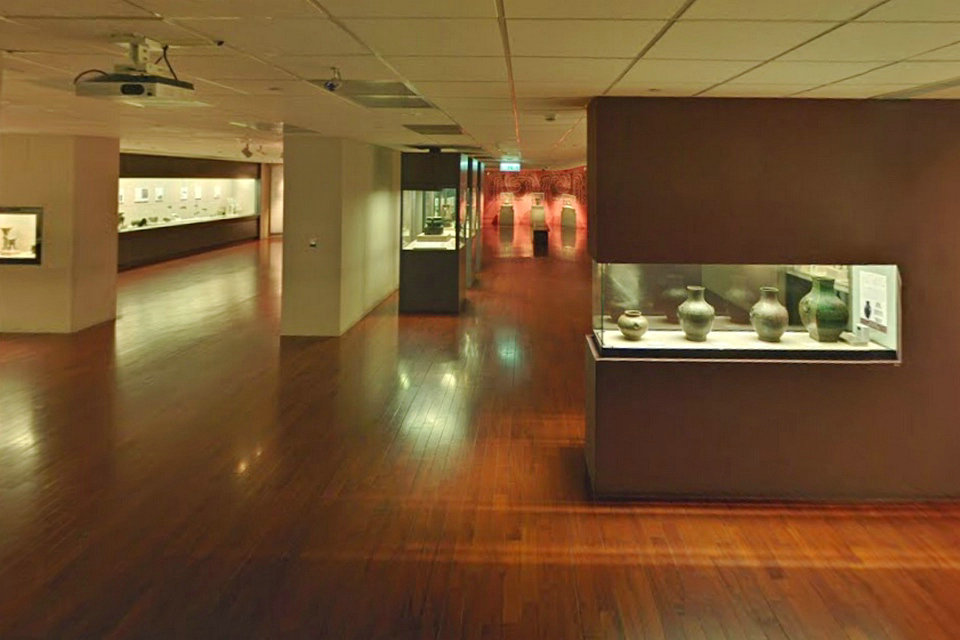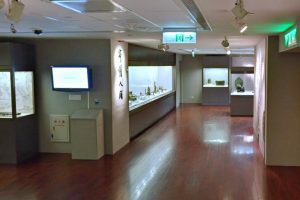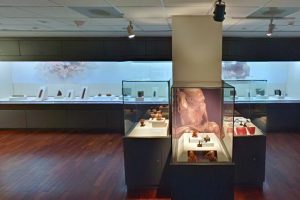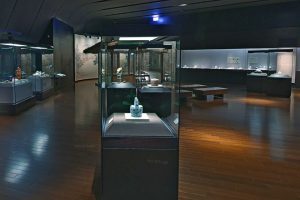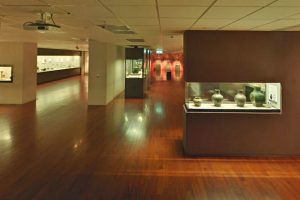The Bronze Age of China started in the late Xia dynasty (c. early 17th century B.C.E.), lasting about 1,500 years through several dynasties from Shang to Western Zhou and Eastern Zhou. Even after the subsequent emergence of iron in Qin and Han dynasties, bronzes continued to be in use.
During those remote eras, only the ruling class was allowed to commission and use the precious bronze vessels. As was said, “worship and warfare are the first and foremost affairs of a state”. Bronze was mainly cast into ritual objects, in addition to weaponry, to offer sacrifices to ancestors for their blessing of an everlasting lineage. Further, from the arrangement and quantity of bronzes displayed in a given ceremony, one can discern the specific social status and position of that noble host. Bronzes were thus the most important ritual objects in the aristocratic Shang and Zhou (1600-220 B.C.E.).
In many aspects, these two early dynasties were crucial to the formation of Chinese culture. Politically, with a burgeoning humanistic awareness the rule by theocracy gradually transitioned to that of rituals and proprieties. Materially, the advanced bronze smelting and casting skills initiated a new age of ritual vessels and weaponry; the breakthrough in craftsmanship and technologies gave rise to a wide range of flourishing industries. Spiritually, the two primary affairs of the state, worship and warfare, conveyed via various shapes and patterns of ritual bronzes the awe for and communion with deities as well as ancestors. Last but not least, the bronze inscriptions recorded the ritual occasions these vessels were made for: feast rites, military action, and reward or conferment ceremonies.
The Bronze Civilization, extolled with the “Rites and Music” of bells and cauldrons, in the “Worship and Warfare” honoring ancestors, and by Zhou’s “Newly Endowed Mandate” and “Elaborate Textual Repertoire”, continued on through the renewed splendors during Eastern Zhou, all the way to the ultimate unification under Qin and Han. Bronzes gradually yielded its central role in the ritual system but transformed into a cultural archetype, deeply imbued into and manifesting the essence of Chinese thought and culture: extensive and elaborate, profound yet moderate.
Rites and Music:
Ritual Objects From Shang Dynasty
The inaccessibility of materials and complexity in making heightened the status of ritual bronzes. They were displayed at the ceremonies and buried with the deceased, respecting life and death in the same quintessence of “Rites and Music”.
By early Shang, bronze vessels had begun to appear in sets. The sophisticated combinations further matured in late Shang, such as commonly seen examples of ding, yan, and li, or gui and dou, in the food vessel category; gu, jue, zhi, and jia, or lei, pou, zun, and you, for drink vessels; yu and pan, as water vessels. The all-pervading presence testifies to the paramount significance of bronzes in that fully-developed stage of a rite-based system.
The most common patterns on bronze objects, shou-mian (animal masks), feng-niao (mythical phoenix), and kui dragons, initially conceived to mediate with deities and ancestors, over the time also evolved into a dazzling array of magnificent, intricate variations, the dragon-and-phoenix pattern being one of the examples.
The elaborate forms and motifs of the ancient bronzes delivered the very first pinnacle in the art of China.
Worship and Warfare:
Clan Vessels and Weaponry During Shang and Zhou
The first instances of bronze inscriptions appeared in early Shang. These simple texts marked the clan crests or names of the persons who commissioned the works and/or their ancestors being paid homage to, providing a most definite way to identify a given bronze vessel.
The existence of various vessels associated with identical clan names reveal not only the solemnity of ancestor worship as an important rite, but the unusual trust and endowments given by the court to these prominent families. The examples include the bronzes that belonged to the Ya-chou clan, and the bronze zun vessel and seal from the Ya-qin clan, both of late Shang dynasty; the Cauldron of Xian-hou and Cauldron of Chi-yu, commissioned by the Tian-min family, early Western Zhou; the wine vessels hu of Zhou-shang and you of Zhou-hu from the mid-period of the dynasty. These vessels were commissioned by the overjoyed recipients of the honors to celebrate their glorious achievements, to offer to the ancestors, and at the same time to pass down to the future descendants.
Worship formed a dialogue between the deceased and the living through time, while Warfare dictated the battles of life and death in space.
Prior to carrying out as battle instruments the spatial struggles with enemies, the bronze shields, daggers, axes, and the like partook as ritual objects in the pre-battle ceremonies to hold temporal conversations with ancestors for their blessing of victory.
The casting of weaponry was indispensable in staging the first and foremost affairs of a state.
These fine, sophisticated bronze weapons signify the exalted rank and elevated status of their noble owners; the inscriptions serve as scripts retelling acts and scenes from ancient historical dramas of Worship and Warfare.
The Newly Endowed Mandate:
Ritual Objects from Zhou Dynasty
The father and son, Kings Wen and Wu of Zhou, defeated the old regime of Shang and another son Duke of Zhou implemented a new institution of governance based on patriarchal feudalism. As “Zhou as a state is ancient yet as a dynasty its mandate is newly endowed” (Shijing the Classics of Poetry), its bronzes also exude an aura of “newness”.
Bronzes made during Early Zhou of the first four kings mostly inherited their shapes and motifs from those of late Shang, with growingly distinctive Zhou flavors (e.g. square-footed gui vessels) when its own rituals evolved toward maturity over the time, as evidenced in the bronze inscription records of jade usage.
Beginning in the mid-period under the subsequent five rulers, the artistic styles made a drastic turn; a multitude of brand-new functions, shapes and designs emerged. The old drink vessels jue, jia, and gu disappeared whereas food vessels such as gui, fu, xu, and pu increased, reflecting the new focus of Zhou on food. Tile motifs and patterns of phoenixes with large, curly tails also made their popular appearances; the inscriptions grew longer, in calligraphic forms and styles totally different from those of the early period.
The late Western Zhou under the final four kings saw another wave of new patterns. The animal masks dissolved into various new decorative patterns: boqu (hooked wave), chonghuan (double rings), and chuilin (vertical scale) and an increasing number of vessels were commissioned by regional feudal states, paving the way for Eastern Zhou’s dazzling local styles. Above all, the most prominent feature of the period belonged in the richness of inscriptions, which denotes an advanced state in the use of writing. Upon this rich cultural soil would one day grow and blossom the refined fruits: the classics of the Chinese classics, the Books of Changes, of Documents, of Poetry, of Rites, of Music, and of History in the upcoming Spring and Autumn period.
The Elaborate Textual Repertoire:
Bronze Inscriptions from Western Zhou to the Spring and Autumn Period
Inscribing on bronzes, either by casting or engraving, is a characteristic of Chinese bronzes which makes them very uniquely different from those made in other cultures.
The rich textual repertoire debuted with mostly clan or ancestor names during Shang and early Zhou, and around the mid-period of Western Zhou increasingly adopted the theme of “For Descendents to Forever Cherish”, which gradually developed into a standard finishing statement for many inscriptions. Other contents also abounded: chronicles of military actions, dowries in marital unions, ceremonies of conferment and endowment, contracts for land ceding, edicts and awards, and so on. They serve as original records vividly documenting what was done and said, delivered in the vocabulary and diction of the time.
The golden inscriptions are the end results of a series of processes which involve engraving, molding, and finally casting, of the handwritten originals; yet the cast texts still manage to reenact the superb calligraphy of the time. The calligraphic styles reflect the gradual development and forming of da zhuan (large seal script), evolving from powerful spontaneity of Shang and early Zhou, to solemn regularity during the mid-period, Wesernt Zhou, and to refined smoothness from late Western Zhou to early Spring and Autumn period. That more and more long texts appeared during mid to late Western Zhou is also a live illustration of Zhou’s “elaborate textual repertoire” “preserved in golden inscriptions”.
Hegemons and Rivalries:
Ritual Vessels, Weapons, and Others during eastern zhou
During Eastern Zhou, the overlord court of Zhou declined and so did the ritual institutions. On the political scene, regional lords rivaled for hegemony where the strong trampled the weak and the many crushed the few. With respect to the rites, class codes of proprieties were discarded and funerals went excessively extravagant above the deceased’s stations. In daily life, the nobility took part in competitive show of luxury; new and innovative articles of all kinds emerged and abounded.
Rituals, music, and military expeditions, the prerogatives and initiatives exclusively the Son of Heaven’s, also moved down the peerage ladder to anyone who could afford. Rites, gears, implements, and seals of credentials full of regional features came out and flourished.
Behind this creativity outburst of material innovation was a spiritual originality at work, in which various schools of thinkers and authors across the spectrum engaged in eager debates of ideas. Confucianism and Taoism were formed; the splendid diversity in spirituality corresponded to material plurality. The spread of knowledge also helped the awareness and rise of a society of commoners as well as the popularity of artistic realism. Amid the contention for ascendancy among the “Five Spring-and-Autumn Hegemons” and later the “Seven Warring States”, the aristocrats’ elaborate sophistication joined by the commoners’ ingenuous simplicity together defined the ethos and shaped the fabric of this turbulent era.
The Glamorous New Age:
Bronzes from the Spring-and-Autumn to the Warring States Period
During the Eastern Zhou period, the regional lords rose to challenge each other for dominance as the central overlord House of Zhou’s power weakened. Against the backdrop of the new ruling class and new cultures Chinese bronzes also entered a new phase of development.
The court-commissioned bronzes that once flourished back in the Western Zhou dwindled and then totally disappeared from the scene. In place of them were new bronzes from regional states, commoners-turned-aristocrats via military exploits, and wealthy industrialists and merchants. The newcomers put even more stress on the ornamentation of their wares, leaning toward a dainty style of exquisiteness in contrast to the grand and solemn manner prevalent in Shang and Zhou. Fancy skills such as inlay and amalgam gilding proliferated, creating artistically elegance and glamour, while the practical aspects of bronzes making were also paid attention. Artisans started to mark their names on bronzes, indicative of a production system of rigor and accountability now in place to meet the requirements of practical use.
Overall, the changes reveal the decreasing importance of bronzes yet the afterglow still glittered, even more dazzling than ever before.
The Post-Bronze Age:
Bronzed from Qin to Han
With the advent of great centralized empires Qin and Han, bronzes turned from august ritual vessels to common daily wares.
Traditional vessels of rites facing different fates, some such as gui, fu, dui, and dou gradually ceased to exist while others for example ding and hu became more utilitarian in nature. The majority of the most desirable wares during Han dynasty were of new genres, including Boshan mountain-shaped incense burners, barrel-shaped zun for wine, hou-lou vessels for soup, and various styles of lamps and lanterns for lighting, all catering to personal enjoyment of a fine, worldly life.
As to ornamentation, the new patterns or designs were either simple or lively, or sometimes teeming with romantic imagination toward immortal worlds. The contents of inscriptions carried more auspicious expressions in addition to being just practical records.
Under the universal rule of the empires, a new, exciting, and magnificent era arrived with full momentum. Though the changeover of the post-bronze age did not take place overnight but the ramifications impacted future Chinese.
A Colorful, Multicultural Presence:
Bronzes in the Frontier Style
As far back as in Shang Dynasty, the surrounding peoples had been via various ways in frequent contact with the Central Plains. Their bronzes were a combination of lively forms and unique patterns.
The colorful multicultural presence existed from late Shang, through Western Zhou, and then into Eastern Zhou, creating a dazzling array of various bronze civilizations, each with its distinctive characteristics. These cultures scattered around in the north (today’s Hebei, Inner Mongolia, Ningxia, Northeast), in Ba & Shu (today’s Sichuan), in Dian (today’s Yunan), and today’s Hunan, Guangdong, and Guangxi. Their bronzes were either influenced by the Central Plains as a result of interactions, or purely exhibiting local arts and variations of their owns.
Finally into the empires of Qin and Han, the unification under one imperial rule brought together from four corners what used to be featured locally. The spread of local bronzes to the Central Plains also helped facilitate the integration process of Chinese Culture.
Taiwan National Palace Museum
The National Palace Museum houses one of the largest collections of Chinese art in the world. With nearly 700,000 precious artifacts, the museum’s extensive collection spans thousands of years and consists of magnificent treasures from the Song, Yuan, Ming, and Qing imperial collections.
In recent years, the National Palace Museum has dedicated itself to melding culture and technology, hoping to make its national treasures and remarkable cultural inheritance more accessible to people around the world.
